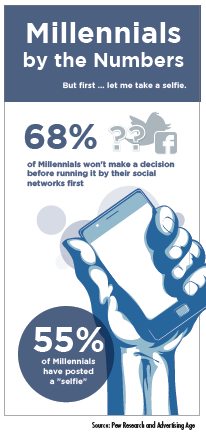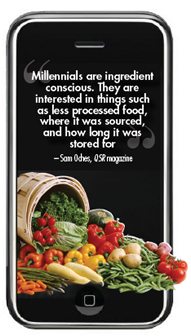
The emerging group of over 77 million Millennials in the U.S. is changing how food manufacturers and businesses are marketing their brands. With the power of digital marketing, the quest for obtaining brand loyalty has become a battle over who Millennials will talk about or mention in their social media posts. However, if you ask a Millennial what they’re tweeting about, it’s probably not the pack of frozen peas they snatched up in aisle 3, or the coupon they clipped in the Sunday paper. Today’s new spenders do care about the foods they consume, but are more heavily swayed by the experience acquired through purchasing them.
When it comes to shopping for food or choosing where to eat, Millennials have become increasingly focused on the big picture, taking into account factors such as customer reviews, brand interaction and environmental impact. This new generation of shoppers, ranging in age from 18 to 36, is extremely self-expressive and socially conscious.With the strong spending potential Millennials possess, businesses must learn to invest and adapt to their unique needs and wants. So if you don’t know what a “selfie” is or how it can apply to your business strategy, now is the time to understand and tap into the millennial mind.
Self-Expression
 Nothing more than a digital self-portrait, the popular “selfie” won the coveted title of Oxford Dictionary’s 2013 Word of the Year and has been integrated in marketing campaigns for major companies such as Purina, Axe Deodorant and Samsung. Customers are asked to submit pictures of themselves to promote their brands in exchange for giveaways, prizes, or being featured in both online and print media. While some may argue that this fad is a bit narcissistic, data shows that Millennials just want to be part of a larger social collective than previous generations.
Nothing more than a digital self-portrait, the popular “selfie” won the coveted title of Oxford Dictionary’s 2013 Word of the Year and has been integrated in marketing campaigns for major companies such as Purina, Axe Deodorant and Samsung. Customers are asked to submit pictures of themselves to promote their brands in exchange for giveaways, prizes, or being featured in both online and print media. While some may argue that this fad is a bit narcissistic, data shows that Millennials just want to be part of a larger social collective than previous generations.
Companies who want to win over the Millennial market are conscious of this generation’s affinity with self-expression, campaigning for customers to post, tweet or chat about their brand. According to a recent Pew Research survey on Millennials, “55 percent have posted a “selfie” on a social media site; no other generation is nearly as inclined to do this.” The percentage contrasts immensely to the 24 percent of Generation X and nine percent of Baby Boomers that have taken part in this trend, per the study. For the Food Industry, asking customers to capture their delight when consuming or using their products can be a clever way to promote business and obtain deeper brand engagement. At the same time, strategic recourse should be established in the event that any negative comments are posted. Swiftly and smartly handling such posts appropriately will help maintain your company’s reputation.
Making Decisions
The biggest factor to consider is that for Millennials, the shopping experience begins before they even set foot in the store or restaurant. They are heavily reliant on the opinions of their vast social connections, and consider social media platforms to be a primary and viable source of information. As a result of being so digitally dependent, Advertising Age reports that 68 percent won’t make a decision before running it by their social networks first.Other studies agree, adding that celebrity endorsements help seal the deal in obtaining brand loyalty from younger Millennials. Companies such as Kellogg’s, which has captivated consumers with its “Tweet Shops,” know exactly how valuable positive comments and endorsements are on social media networks. Visitors of these traveling pop-up shops simply pay for a box of snacks with a tweet. The alluring incentive of paying with social currency is now catching on with companies outside of the Food Industry, such as designer Marc Jacobs, who gave out free purses, perfumes and necklaces to customers with the best Instagram photo during this year’s Fashion Week in New York.
The key to using technology and social media, however, is not just about the presence, but about the functionality and value. Nielsen’s 2014 study on Millennials states that “When interacting with companies via social media, they value authenticity – they want to feel they have a personal, direct interaction with the brand – and in return, they’ll advocate and endorse that brand.” For companies, this means listening to the consumer, and designing products and campaigns that create memorable impressions. Interactive storefronts or kiosks, simple ordering solutions, and easy in-store or online navigation are examples of how companies can put their customers at the top of their priority list.
Advocacy & Social Impact
When it comes to Millennials, a brand’s products are just as important as its beliefs and philanthropic ventures. According to Sam Oches of QSR magazine, this new generation of consumers is proving to be very loyal to brands, showing a strong pull towards socially conscious and environmentally-friendly businesses. “Millennials like to see the actual work of the companies they go to. They think about social responsibility and are interested in companies that offer time and money to charitable causes and local communities.”
Companies who genuinely share such values in their business model are tugging strategically at the Millennial heartstrings. Whole Foods is a prime example of this. Not only does it support local farmers, but five percent of its sales go to nonprofit organizations Like other companies, it also collects and donates items for the needy. This fares well for other businesses looking to win over today’s Millennials, many of which raise money for nonprofits or advocate for them through online platforms at an early age. On the other hand, companies must keep in mind that if customers don’t agree with their advocacy, it could dissuade them from engaging with the brand.
Diversity & Food Selection
Millennials in the U.S. are the most diverse generation so far, and it is making a difference where they shop or dine. Fast casual restaurants that feature authentic ingredients are gaining strength, appealing to Millennials who are more willing to try new foods. Per Nielsen, this generation appreciates the influence of other cultures more than theBaby Boomer generation, and has a deeper connection to cultural traditions and tastes.
gaining strength, appealing to Millennials who are more willing to try new foods. Per Nielsen, this generation appreciates the influence of other cultures more than theBaby Boomer generation, and has a deeper connection to cultural traditions and tastes.
“There is a lot of growth with ethnic food especially in fast casual dining. Companies like Chipotle, who offer real authentic Mexican food and ingredients, have found a lot of success. This success is traced largely to Millennials because they seem to have bolder palates and are more adventurous when they dine out,” explains Oches.
Chipotle is actually at the top of the list of favorite restaurants among Millennials, who are equally interested in the ingredients in their food. The brand successfully appeals to consumers by standing fim on its “food with integrity” philosophy, and providing content on how it responsibly sources its ingredients. Grocery stores and markets are also catching on by providing more international food options with unique and health conscious ingredients.
The new generation of consumers poses an exciting time in the food industry, as it pushes for higher standards while opening the door to innovation.
A New Strategy
The new generation of consumers poses an exciting time in the food industry, as it pushes for higher standards while opening the door to innovation. For companies looking to adapt, the challenge lies in juggling all of these qualities in a way that Millennials will notice. “Millennials are ingredient conscious. They are interested in things such as less processed food, where it was sourced, and how long it was stored for,” says Oches, “but they also care about the people working in the stores, and the community dollars that are given. They are concerned about all of the players involved.”
